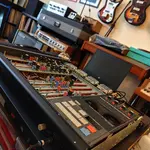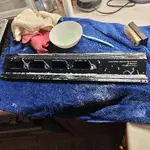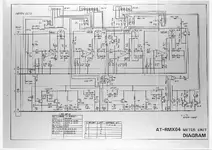Let there be light…
View attachment 128385
Yes…got the meter lamps replaced which, thanks to
@famous beagle ‘s tutorial on the subject elsewhere on this very forum (just do a search for threads started by him with AT-RMX64 in the title and you’ll find it…), was a breeze…I’m polishing the meter bridge metalwork, and still need to clean all the knob and switch caps, but then I’ll put it back together and call it “done.”
I’ve been working on other things and also manhandling daily life, but I did do a bunch of other general investigative work into the guts of the AT-RMX64 because, unfortunately, I think until a miracle surfaces, I’ve lost all hope of obtaining tech docs for this thing…and I think with help from friends I’ve done a yeoman’s job trying. I wish the buyer of the full-size schematic set on eBay a couple three years ago would see this and do the AT-RMX64 community a solid, but that’s probably not happening…or Michael Dewenter of transanalog.com would respond…I’ve sent many emails through his website at this point with no response, and three years ago when I did connect with him via email he confirmed he had the documents, but had just moved and didn’t have his scanning equipment or documents available…totally respect that. But it’s been crickets since. So we know the documents are out there, but nobody is helping. I didn’t share this earlier but I have a good friend who has been in electronics for decades, super smart, worked for Tapco and Mackie among other companies designing consoles, still does quality sound reinforcement engineering to this day…connected…turns out he knows somebody at AT America that remembers the AT-RMX64 and was willing to go fishing…dead end. SO…I said fuck it and took to reverse engineering.
I have a complete electrolytic cap list by PCB with audio path caps identified for anybody that feels they need to recap. It will help you with your shopping. It also calls out differences between early generation and late generation AT-RMX64s, because there are some differences (limited) in the caps…
I also have almost every pin of the input modules mapped, and many of the sub modules…I figured out the signal flow through the record, bias and playback amplifier PCBs in the transport section.
I’m really busy so I haven’t put any thought to how to disseminate this information, but if you need it hit me up…I basically spent a big chunk of quality time mapping it out.
If nobody helps you, you have to help yourself.
Anyway, that’s the update. I’m on the cusp of having a fully operational 9/10 condition AT-RMX64 and have a butt-load of guts-knowledge now to support the device.
OH…and I think the main difference between the early and late generation units is a 555 IC timer circuit for muting when arming tracks. I should capture a video of the muting action on mine, but basically on the Mother C Unit of the later generation machines, which is the motherboard under the back connector of the SUB modules and the transport cards, there is an added 555 IC timing circuit, and related circuitry on the record amp PCB and SUB modules that mutes all output from any armed channels when you make changes to the track arming. That means there are differences in the record amp unit, mother C unit and SUB modules between early and late machines…not compatible. Test it…put in a cassette, send some signal to all 4 sub modules, arm all 4 tracks and turn up the record level…set all the meters to TAPE…put the transport in REC-PAUSE. You should now see level on the 4 meters. Take one track out of armed status. When you do this on a late generation machine, all tracks should go dead level-wise for a second or so, and then pop back. That’s the timer muting circuit working. I believe if you do this on an early machine you won’t see the muting action, and may hear switching artifacts in the outputs if monitoring. No big deal, and honestly it speaks to the relative fancy nature of the project that is the AT-RMX64 that they took the time to do this midstream in production, but it’s good for folks to be aware of. IMO I don’t think it makes late gen better than early gen, it still the same signal path and transport, etc., but it DOES mean incompatibilities in some of the PCB assemblies.
Okay.
That’s all for n






